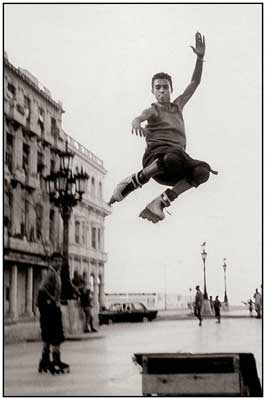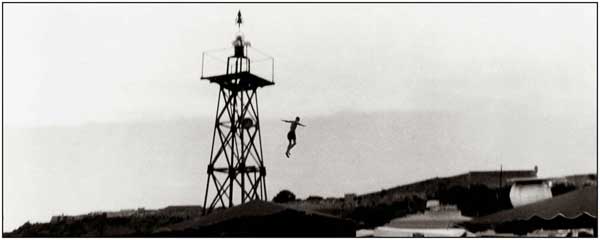Cuban Photographer Pedro Abascal
Yanelys Nuñez Leyva

HAVANA TIMES — Considered one of the greatest exponents of Cuban photography in recent times, Pedro Abascal — self-taught — involves us in each of his images of the varied themes of Havana life.
After first getting a close look his work while doing research on documentary photography, I was led to interview him at his home, located in one of the most pleasant areas of the capital: Havana del Este.
The benefits from this conversation were many, since I found in this artist a professional of our culture who was passionate for photographic knowledge.
His work began in the 1980s and is in the same vein from how he currently realizes his art. He still allows himself to be seduced by the reflections that inundate the streets and that construct unlikely and chaotic atmospheres. He still attempts to catch instances in which human beings unfold and unwittingly express life as it is.
For those interested in learning about the latest photographic productions by Abascal, these can be found at the Espacio Abierto Gallery of the magazine Revolucion y Cultura (located near the corner of 11th and 4th streets in the Vedado district).
This exhibit opened on May 10 as part of the activities of the Eleventh Havana Bienal arts festival. The exhibition, entitled “Habana Color,” shows moments of everyday life in the capital, captured from a “lens” that exploits the expressive and evocative possibilities of color.
The questions I posed here sought to delve into the artistic concerns of this renowned photographer.
HT: What were your first concerns — about topics, techniques, etc. — in the field of documentary photography?
Pedro Abascal: I would like to state here what is an essential criterion: For me photography doesn’t have labels – it’s just good or it’s bad. I think the distinctions like documentary, conceptual, artistic, etc.., etc., in addition to being reductionist, burden the positive development and understanding of the medium, these terms are in no way antithetical or exclusive – as unfortunately they’ve been used by critics, scholars, curators and even photographers themselves.
My first concerns — which continue to be the same ones today — were directed at the understanding of the environment as a whole, based on technical rigor and through the understanding of language and, of course, history. The systematic and thorough study of these issues is what has allowed me to develop my work and help other young people to do so, even to respond to interviews.
HT: Do you consider the photo essay an ideal medium for communicating ideas and concepts?
PA: I definitely think the photo essay published in book form is an effective and powerful medium when it comes to conveying the message that the work contains. The photo essay begins and ends where the author includes the elements that they consider appropriate for illustrating their ideas and handling concepts.

HT: In 2003, the Fototeca de Cuba photo library presented a set of your photographs under the title Documentos personales. What concerns were reflected in the images that were exhibited?
PA: I think that all of my work is marked largely by the existential questions of who we are, why we are and where we’re going. Photography has the ability — even when one cannot escape the referent — to be able to transcend it. The great Mexican photographer Nacho Lopez once said, “Other means of expression silence the conscience, while photography exalts it.”
HT: How do you consider projects like “Happy Landscape” (2005) and “Laberinto” (2006)?
PA: “Happy Landscape” was a video installation that projected on the gallery wall a series of photographs in a slow transition that changed the landscape of space. “Laberinto” was an installation made up of color photographs of stained glass of Havana mounted on large Plexiglas brackets distributed in the form of a labyrinth, which reproduced the effects of the reflections of the images, creating an illusion in the viewer.
HT: What other shows in the 2000s marked the direction in your career in terms of the importance of the photos exhibited or the work presented in conjunction with other creators of the medium?
PA: There was “Demasiado Humano,” an exhibition in 2001 at the Wifredo Lam Contemporary Art Center that was co-curated by the artist Hilda Maria Rodriguez, a visual arts specialist and the director of the center at that time. She’s now a professor at the Faculty of Arts and Letters of the University of Havana.
HT: How do you view the contemporary Cuban photographic movement?
PA: It’s interesting what’s happening with the contemporary Cuban photographic movement: There are more and more young photographers, artists, and enthusiasts of photography in general with talent who are undertaking work. Nonetheless, in the vast majority of instances they suffer from a lack of knowledge since there’s no institution or school specializing in photography.
From my point of view, in the different schools of art education, the study of the history of international and national photography isn’t very deep or rigorous. In a general synthesis, it could be said that this movement enjoys good health, even though this needs to be strengthened with a good academic foundation. I also think there’s a significant lack of critical forums for debate and discussion about issues concerning the art form.
HT: Do you believe that today there’s a greater interest on the part of cultural institutions in promoting the work of documentary photography?
PA: If there is such interest by institutions, I don’t see any major actions aimed promoting it. While I recognize that in my case my work has been recognized and promoted to a certain degree, especially in recent times, I can’t say the same in the field of commercialization. People are much more focused on so-called “art photography,” a term I really don’t get.
HT: Do you think there are points of contact with regard to the issues addressed by documentary photographers in their work?
PA: Probably. The themes and ideas are all in this “sea of Solaris,” which is the collective imagination and life that concerns us all.
HT: To conclude, how would you define these last ten years of your creative work?
PA: Intense and productive, but time will have the last word.






Hi Dan,
My wife and I are planning to visit Cuba from may 9 till may 19, 2013. I am a “pretty advanced amateur” and am looking to shoot a real top series in Cuba. For that I am planning on bringing my digital Hasselblad equipment with me.
I am now looking for an experienced, locally knowledgable, photographical “guide” that can help me to setup the best sets and maybe to help finding the best spots and people to shoot. Somebody who knows and speaks the local language and knows the local habbits.
I noticed your site and was wondering wheter you would by any chance be in Cuba at the same time and would be interested in teaming up?
Thanks for your respons,
Kind regards,
Peter Dorr
The Netherlands